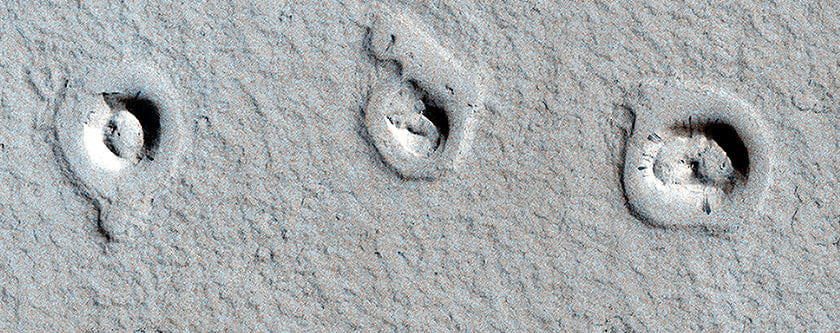Although these strange features on Mars look a bit like hieroglyphics or geoglyphs such as the mysterious Nazca lines on Earth, they are completely natural features, ones that are found on Earth too.
This is one of the latest images from the
HiRISE camera on the Mars Reconnaissance Orbite
r.
Called 'rootless cones,' they form on lava flows that interact with subsurface water or ice. Their formation comes from an explosive interaction of lava with ground ice or water contained within the regolith beneath the flow. Vaporization of the water or ice when the hot lava comes in contact causes an explosive expansion of the water vapor, causing the lava to shoot upward, creating a rootless cone.
Dr. Alfred McEwen, HiRISE Principal Investigator, described the ancient lava flow as 'inflated.' "Lava inflation is a process where liquid is injected beneath the solid (thickening) crust and raises the whole surface, often raising it higher than the topography that controlled the initial lava emplacement," he wrote on the HiRISE website.
The scene above is located in Amazonis Planitia on Mars, a vast region covered by flood lava. McEwen said if this image were in color, we'e see the surface is coated by a thin layer of reddish dust, which avalanches down steep slopes to make dark streaks.
Similar features are found in Iceland, where flowing lava encountered water-saturated substrates.
[caption id="attachment_100193" align="aligncenter" width="250"]
Rootless cones (a) on Mars and (b) in Iceland. The scale of the Martian and terrestrial cones are comparable. Credit: University of Hawaii/Mars Orbiter Camera/MSSS.[/caption]
Just how big are these strange features on Mars and how old are they? "The cones are on the order of a hundred meters across and ten meters high," Colin Dundas from the US Geological Survey told Universe Today. "The age of these specific cones isn't known. They are on a mid- to late-Amazonian geologic unit, which means that they are young by Martian standards but could be as much as a few hundred million to over a billion years old."
If subsurface water or ice was part of their formation, could it still be there, underground?
"The water or ice that led to the formation of these cones was likely within a few meters (or less) of the surface, and so it's probably not there anymore," Dundas said. "At this low latitude (22 degrees north), shallow ground ice is currently unstable, and should sublimate on timescales much less than the likely age of the cones."
Dundas added that since ice stability varies as the obliquity changes, it's even possible that ice has come and gone repeatedly since the lava erupted.
See more views of this region on Mars on the
HiRISE website
 Universe Today
Universe Today
